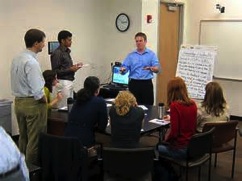HR Professionals: As part of your strategic role, you can apply your skill sets to help Line Supervisors to build  productivity, to transform their departments into performance-building teams through friendly competition, peer pressure and mutual support.
productivity, to transform their departments into performance-building teams through friendly competition, peer pressure and mutual support.
Are some of your supervisors leading people working as individual contributors, direct or indirect labor, in production-focused functions? Sometimes people find it increasingly difficult to motivate themselves to perform at their very best in environments where the work they do is repetitive and similar from day to day. This can happen in both office and manufacturing departments.
By building a team environment a supervisor can enable his people to build mutually supportive work relationships, re-energize themselves, and build performance. It’s helpful to use a variety of approaches over time.
As an HR professional, you probably have knowledge and skills that supervisors often need to develop, to strengthen their leadership capabilities. For example, meeting management, facilitation, rewards and recognition, and presentation skills may be strengths you have that are essential to implementing team leadership initiatives such as the Game Plan below.
This 3-step team strategy is one you might want to help supervisors to use. As you review each step of this Game Plan, identify ways you can support and coach supervisors to do a great job of implementation.

Team Game Plan
Resources Needed:
- Whiteboard
- Flipchart
- Markers
- Time ear-marked for two 5-10 minute team gatherings per day, in an area not disrupted by noise or interruptions
- A manual or automated method to collect performance data; ideally, data will be available real-time, or at least daily.
3 Steps:
- Plan the day. Gather your people together10 minute discussion at the start of their workday.
- Communicate the day’s production goals (Put the goal on the Whiteboard)
- Facilitate a group discussion about the goals, to anticipate obstacles and develop solutions and preventive actions. Record anticipated issues and action items on the Flip-chart. Involve your team members in the discussion and in recording the information on the flipcharts.
2. Review progress. Pull your group together to update them on progress, sharing data on performance against the goal.
- The team’s performance data (not individual performance) should be included with the goals on the whiteboard. Ideally, you’ll do this mid-workday, discussing that day’s performance.
- However, if your data for that day is not available due to system limitations, you may need to schedule your progress update at a different time. In either case, a mid-day update will enable you to hold a follow up discussion on the earlier anticipated obstacles and the action items — re-energizing and renewing team-focus on the day’s plan.
- Keep the meeting fast-paced, discussing issues and actions, not blame or side-issues.
- Provide each team member with a handout including his own individual performance as well as the team’s performance as the meeting ends.
- Establish a Winners’ Circle. Make sure you communicate about this in advance, i.e. during goal-setting, explaining how people will be selected for inclusion in the circle. Typically, people join the day’s Winner’s Circle as a result of meeting individual performance goals for the day. Use a whiteboard and keep a daily, a weekly, monthly and calendar-year record. Keep these visible to the group continuously.
- Put individual names into the circle based on factual performance data.
- Set goals to grow the numbers of people in the Winners’ Circle. As each of these goals is met, raise the goal, with the outcome of eventually achieving 100% of team membership in the Winners’ Circle. Reward the entire team with small gift cards as they achieve these goals.
- This will encourage people to help one another to improve performance. It will also generate an element of peer pressure to perform. Provide individuals with training as needs are identified by the individuals or by you as supervisor, ensuring it is done as a developmental activity vs. as a punitive action.
Implemented with a positive purpose of getting everyone more involved in planning and problem-solving to improve team results, this type of Team Game Plan can help a supervisor to build a new spirit of camaraderie, mutual respect and a climate of performance.
What are some other ways you’ve experienced or implemented that helped engage people and bring out their best performance and team spirit?
Latest posts by Rosanna Nadeau, PCLEC (see all)
- Is Quality Being Lost In Today’s Quest For Efficient Execution? - August 31, 2023
- What is HR’s Strategic Role? - August 24, 2023
- Agility: The Ability to Zig and Zag - August 23, 2023











